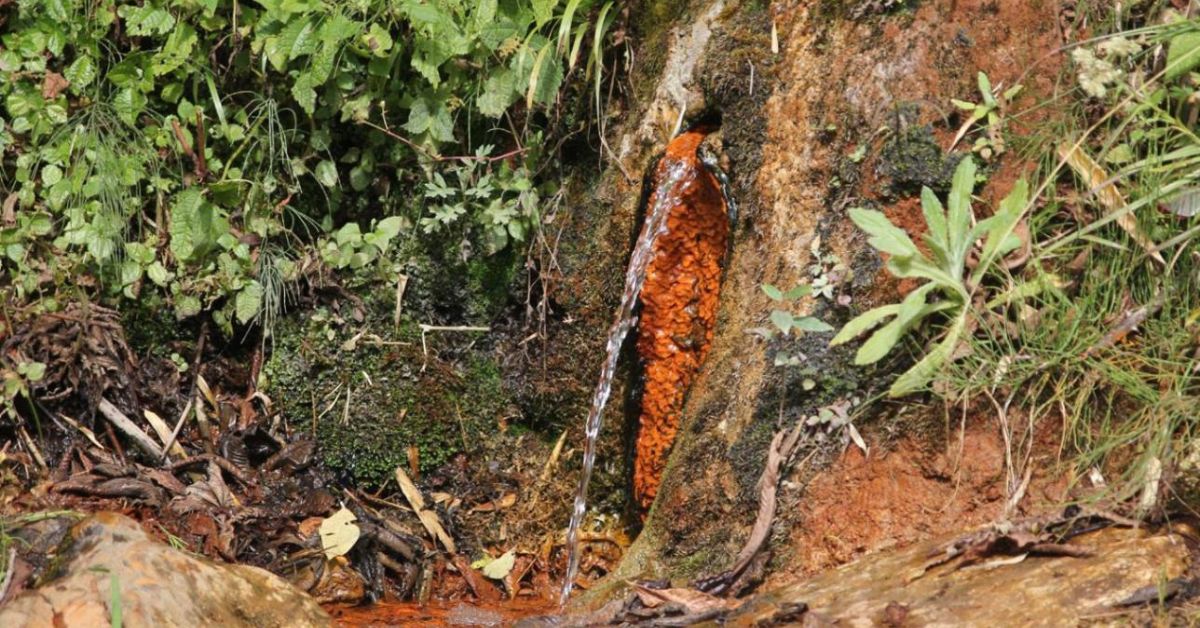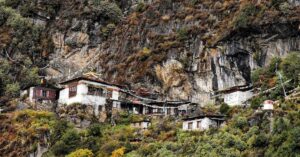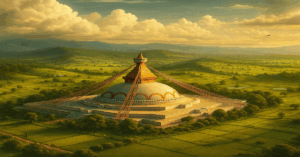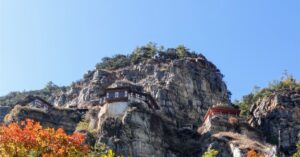Menchu or medicinal (mineral) springs are naturally occurring springs that produce water rich in dissolved minerals, salts, and gases. It is believed that great Buddhist masters like Guru Rimpoche have blessed the medicinal waters or mineral springs. Many important religious sites in Bhutan have medicinal spring water extracted by the founder of the place. Bhutanese people have long used Menchu as a spiritual blessing and for bathing.
A medicinal water or mineral spring is called Menchhu in Bhutan. Bhutan has more than 17 medicinal or mineral springs (Menchhu), 10 hot springs (Tshachu), and more than 17 holy spring waters (Drupchhu). These spring waters are considered the most popular and spiritually significant in Bhutan.
The Bhutanese have used it for generations to drink or wash in the water of these springs. It is equally popular as hot springs and has many claimed medicinal benefits. However, the Menchhus are collected in wooden bathtubs and warmed by heated stones before dipping in the medicinal spring water. The bathtub is generally fixed and available at the site.
Also Read: Guru Rinpoche in Bhutan: His Visits to Bhutan and Sacred Sites
Bhutanese Beliefs on Menchhu or Medicinal (mineral) Springs
There are more than 17 medicinal springs distributed all over Bhutan, ranging from an altitude of 870 to 3365 masl. A common folk belief is that a medicinal spring emerges from the ground due to the asceticism and blessings of the Buddhas and Bodhisattvas.
These spring waters are believed to have been extracted by a spiritual master using his or her power to perform miracles. Medicinal spring waters are believed to have been miraculously unearthed by enlightened beings.
Thus, Bhutanese believe that medicinal springs are very sacred and that they can cure many diseases. Mineral springs possess both purging and healing powers. There is a belief among the Bhutanese that the stronger the smell, the better its medicinal value.
Also Read: Bhutanese Beliefs on Drupchhu or Holy Spring Waters in Bhutan
Medicinal (mineral) Springs in Bhutan
- Aja Menchu
- Baykan Menchu
- Bharab Menchu
- Bjagay Menchu, Gasa
- Bjagay Menchu, Paro
- Chethgang Menchu
- Dangchu-Wangchu Menchu
- Dangkhar Menchu
- Dhonphangma Menchu
- Dobji Menchu or Milarepa’s Menchu
- Drakchu Menchu or Draagchu Menchu
- Kabisa Menchu
- Khabtey Menchu
- Loyee Menchu
- Mage-Phenday Menchu
- Menchugang Pho-Mo Menchu
- Tokay Menchu
Organoleptic Properties of Menchu (Medicinal Springs)
Medicinal waters or mineral springs in Bhutan are known for their unique organoleptic properties. Most mineral springs possess a characteristic rotten egg or sulfurous odor due to the hydrogen sulfide gas (colorless water-soluble gas). However, some have different odors. For example, Baykan Menchhu in Choekor Gewog of Bumthang Dzongkhag has a rock salt odor.
The mineral springs are often associated with reddish-brown or yellowish-colored water sources or sites, likely due to the high mineral content. Bharab Menchhu in Dungkar Gewog of Lhuntse Dzongkhag has a peacock feather color. Kabisa Menchhu in Kawang Gewog under Thimphu Dzongkhag is darkish in color and heavy in nature, while Dangchu-Wangchu Menchhu in Dangchu Gewog of Wangdue Phodrang Dzongkhag is sky blue. Bjagay Menchhu and Tokay Menchhu in Khatoe Gewog under Gasa are light, while Loyee Menchhu is inhabited by green algae and is dense and heavy.
The mineral springs can have a variety of tastes, including sour, bitter, sweet, and mixed flavors, depending on their specific chemical and mineral composition. Bharab Menchhu, Kabisa Menchhu, Loyee Menchhu, and Dangchu-Wangchu Menchhu are sweet and sour, while Bjagay Menchhu of Gasa and Tokay Menchhu are only sour. Dobji or Milarepa’s Menchhu in Dokar Gewog of Paro Dzongkhag tastes like normal drinking water.
The organoleptic properties of Aja Menchhu, Bjagay Menchhu of Paro, Chethgang Menchhu, Dangkhar Menchhu, Dhonphangma Menchhu, Drakchu Menchhu, Khabtey Menchhu, Mage-phenday Menchhu, Menchugang Pho-Mo Menchhu are not available.
Types of Natural Menchhu or Medicinal (mineral) Springs
The Menchu or mineral spring water is categorized into five types, based exclusively on the diseases they can cure:
- Menchhu that heals wind disorders (rlung sel-ba’i sman-chu),
- Mineral spring that heals bile disorders (mkhris-pa sel-ba’i sman-chu),
- Medicinal water that heals phlegm disorders (bad-kan sel-ba’i sman-chu),
- Mineral spring that heals blood disorders (khrag sel-ba’i sman-chu), and
- Menchhu that heals wounds (chu-ser sel-ba’i sman-chu).
Chemical Compositions of Menchhu or Medicinal (mineral) Springs
According to the traditional health care services known as Bhutanese Sowa Rigpa medicine, the mineral or medicinal springs contain either sulfur (mu-zi), calcium carbonate (cong-zhi), mineral pitch (brag-zhun), iron oxide/limonite (sindhu-ra), or a mixture of these components.
However, there haven’t been any scientific geochemical investigations to measure their mineral concentration.
Also Read: Chemical Compositions of Hot Springs or Tshachu in Bhutan
Ethnopharmacological Benefits of Menchu or Medicinal (mineral) Springs
Bathing in mineral springs directly helps the skin absorb minerals like calcium, sulfur, iron, magnesium, potassium, silicon dioxide, salt, and fluorine. This can help heal skin diseases, including psoriasis and atopic dermatitis. Medical Hydrology has long used sulfurous mineral waters to treat various illnesses.
The common ethnopharmacological uses of Menchhu or medicinal springs are to cure diseases and ailments. For instance, the popular mineral spring water, Kabisa Menchhu, has been long used by people for treating conditions such as migraine, headaches, sinusitis, stomach inflammation (ulcer), backache, fracture, sprain, joint pain, gout, arthritis, abscesses, and skin diseases.
Kabisa Menchhu and Bharab Menchhu are beneficial, especially for women suffering from delivery complications and recovering from maternity sickness.
Aja Menchhu is believed to cure 18 different types of diseases (nad-rigs bco-rgyad in Sowa rigpa), including tuberculosis, body aches, ulcers, and whooping cough. The Dangchu-Wangchu Menchhu is believed to be useful for 13 different types of diseases known as gNey- Rig-Chusum.
Also Read: Aja Ney, a Sacred Site of a Hundred Inscriptions of the Syllable ‘Aa’
Drinking Loyee Menchhu is beneficial for persons suffering from asthma and tuberculosis, while drinking Bharab Menchhu is known for healing combined diseases of wind and defective bile, arthritis, body aches, and tuberculosis. Bharab Menchhu and Khabtey Menchhu are the only warm mineral springs.
The hot stone bath with Ura Drakchu Menchhu benefits people suffering from arthritis, stomachaches, skin diseases, and eye disorders. At the same time, the Chethgang Menchhu and Khabtey Menchhu are known for healing arthritis, backaches, body aches, fever, and joint pains.
Gasa Bjagay Menchhu is believed to cure arthritis and joint pains, while Paro Bjagay Menchhu is commonly used to treat fractures, ulcers, cardiac diseases, physical wounds, and arthritis. The Baykan Menchhu and Gasa Bjagay Menchhu are useful for phlegm and bile disorders.
Dangkhar Menchhu effectively cures headaches, hemorrhoids, tetanus, swollen limbs, joint pains, tuberculosis, and ulcers. At the same time, Dhonphangma Menchhu is specifically beneficial to people suffering from dizziness and headaches.
Tokay Menchhu effectively cures phlegm, headaches, blood disorders, gastritis, and stomachaches. At the same time, Dobji or Milarepa’s Menchhu heals fractures, diseases induced by colds, dyspepsia, blood pressure, backache, urinary tract infections, food poisoning, ulcers, and diabetes. Currently, the Menchhu is famous for curing cancers.
Mage-Phenday Menchhu cures sore infections, inflamed wounds, and other skin diseases. Menchugang Pho-Mo Menchhu is useful for sexually transmitted diseases (STDs) and severe dermal disorders such as scabies and leprosy.
Best Time to Visit Menchu or Medicinal (mineral) Springs
Before going to a hot spring, people consult an astrologer to decide the optimum time to go and to get detailed instructions on how to get the most therapeutic advantages.
Bhutanese believe that the best time to visit Menchu or medicinal (mineral) spring water is in winter or spring. The culture of Menchu bathing thrives in Bhutan today and has better facilities. You can visit major medicinal spring waters in Bhutan with the Bhutan Pilgrimage Package.
Enjoyed reading this blog?




